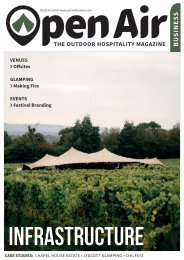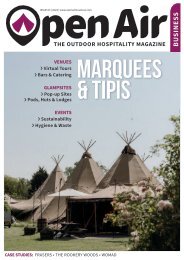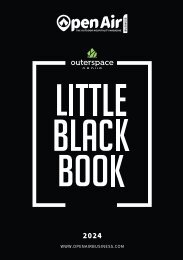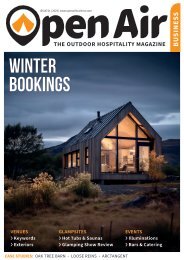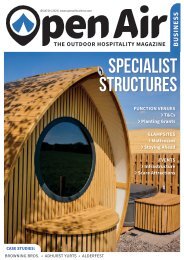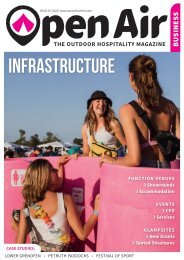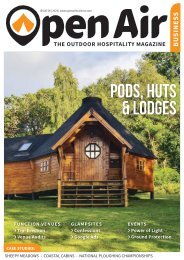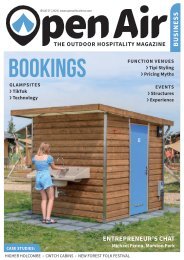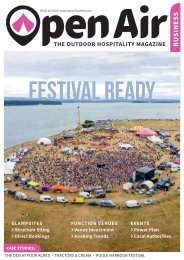Open Air Business April 2017
The UK's outdoor hospitality business magazine for function venues, glampsites, festivals and outdoor events
The UK's outdoor hospitality business magazine for function venues, glampsites, festivals and outdoor events
Create successful ePaper yourself
Turn your PDF publications into a flip-book with our unique Google optimized e-Paper software.
FUNCTION VENUES<br />
Guide to space required, in square metres<br />
No. of Standing Seated Seated at Seated at Banquet<br />
Guests Theatre Style Long Tables Round Tables (8 per 5ft<br />
(10 per 5ft round) round)<br />
25 16 25 36 36 54<br />
50 36 54 54 54 81<br />
100 54 90 100 100 135<br />
150 90 135 162 162 180<br />
200 126 162 240 240 240<br />
300 180 240 300 300 360<br />
500 300 375 525 525 675<br />
1000 525 800 1000 1000 1200<br />
2000 1000 1500 1800 1800 2250<br />
attractive when laid well. More<br />
sophisticated solutions involve a<br />
solid floor with or without carpet<br />
or matting laid on top. Ask your<br />
hirer about their policy for cleaning<br />
matting - do they clean it between<br />
every event, or just every now and<br />
then?<br />
Will you have a band or other<br />
entertainment that requires a<br />
stage? When deciding on the type of<br />
stage, do check with entertainers if<br />
they require a certain size of stage,<br />
or whether they need a stage at<br />
all – they may be able to perform at<br />
ground level.<br />
Regarding dance floors, think<br />
about the number of guests<br />
expected at the function and how<br />
many are likely to be dancing at one<br />
time. Use your hirer’s experience<br />
to decide on the size of dance floor<br />
needed. Dance floors take up space<br />
of course, so over-specifying the<br />
size not only increases the cost<br />
of the dance floor itself but may<br />
require a larger structure as well.<br />
LIGHTING<br />
There are a bewildering array of<br />
lighting options available, from<br />
simple white light to complicated<br />
moving head lights that can create<br />
extraordinary effects. External<br />
lighting may be needed to light the<br />
way to the car park for the guests,<br />
or to highlight dramatic external<br />
features (specimen trees, statues or<br />
building frontages for example).<br />
Your hirer should be able to<br />
advise on lighting rigs suitable for<br />
their structures, and offer different<br />
levels from simple white light to<br />
something more sophisticated.<br />
POWER<br />
A safe and sufficient power source<br />
is essential for any event. There are<br />
three main options:<br />
› Running a cable or two from a<br />
domestic 13A mains socket - fine<br />
for events that don’t require much<br />
power, and where the mains<br />
sockets are not too far from the site<br />
(long cables result in voltage drop<br />
which can mean that equipment<br />
will not function). A Residual<br />
Current Device must be included in<br />
the circuit at the mains socket.<br />
› Wiring into a fuse board – this is<br />
suitable for events requiring more<br />
power where the fuse board is not<br />
too far from the site. Wiring into<br />
a fuse board is potentially lethal<br />
and must only be carried out by a<br />
properly qualified electrician.<br />
› A generator - generators come<br />
in a range of sizes to handle the<br />
smallest events right up to a large<br />
festival. ‘Super silent’ generators<br />
are available which make little<br />
more noise than a diesel car engine.<br />
Generators must only be installed<br />
by a properly qualified electrician.<br />
HEATING<br />
With modern heaters there is no<br />
need to be cold inside a marquee<br />
or tent. The trick is to have<br />
enough heaters. Heaters other<br />
than electrical heaters should be<br />
‘indirect’ - they will have an exhaust<br />
system and sit outside the tent,<br />
blowing warm air in through flame<br />
retardant ducting running under<br />
the edge of the canvas or through a<br />
specially made cut out in the wall.<br />
Check how long the heaters can<br />
run for on a full tank of fuel. If you<br />
ABOUT MUTA<br />
MUTA is the UK’s only<br />
trade association<br />
dedicated to<br />
marquees, tents and<br />
structures. Since 1919<br />
it has been working<br />
to improve standards<br />
in the industry, and<br />
its Best Practice<br />
Guide is followed by<br />
members, which are<br />
also inspected against<br />
it. www.muta.org.uk /<br />
01379 788673<br />
expect to exceed that time, ensure<br />
there is spare fuel on site and<br />
someone who knows how to refuel.<br />
Bear in mind that if there is snow, or<br />
a risk of snow, the marquee or tent<br />
must be heated at all times (day<br />
and night) to prevent a build-up of<br />
snow on the roof.<br />
LOGISTICS<br />
Agree with your hirer the erecting<br />
date(s) and date on which the<br />
structure will be complete ready for<br />
you to use. Ensure that someone<br />
responsible is available at the<br />
time the hirer arrives on site to<br />
confirm exact positioning of the<br />
structure. Also ensure that someone<br />
responsible is available at the<br />
time of completion for the formal<br />
handover of the structure from the<br />
hirer.<br />
Stagger the arrival of the various<br />
contractors to site. For example,<br />
there is no point having the caterers<br />
arrive to lay up the tables if the<br />
marquee or tent is still being built.<br />
Agree with your hirer the<br />
dismantling date(s). Ensure that<br />
someone responsible is available<br />
at the time the hirer arrives for<br />
dismantling, so that a formal ‘hand<br />
back’ of the structure can happen.<br />
Your hirer will usually carry out an<br />
inventory check with you at this<br />
time to ensure nothing is missing.<br />
SAFETY<br />
Check that your hirer will be<br />
following MUTA’s Best Practice<br />
Guide and don’t be afraid to ask<br />
to see their safety policy, risk<br />
assessment, method statement,<br />
flame retardancy certificate and<br />
structural calculations for the<br />
structure proposed. If erecting<br />
requires use of forklifts or other<br />
plant, ask to see the licences of<br />
the drivers. Be sure that your<br />
hirer is aware of the position of<br />
underground and overhead services<br />
(eg drains, gas pipes, electrical<br />
cables, irrigation systems, etc).<br />
Ensure that furniture is laid<br />
out allowing access to fire escape<br />
routes and fire exits. Ask your<br />
hirer for advice on the regulations.<br />
Consider fire precautions, we<br />
recommend as a minimum a water<br />
and CO2 fire extinguisher by each<br />
fire exit.<br />
20 WWW.OPENAIRBUSINESS.COM




